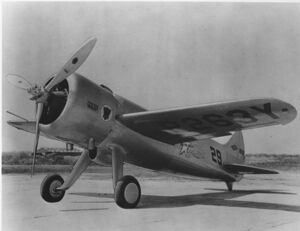Engineering:Laird-Turner Meteor LTR-14
| Meteor LTR-14 | |
|---|---|

| |
| Role | Racing aircraft |
| National origin | United States |
| Manufacturer | Lawrence Brown Aircraft Company |
| Designer | Roscoe Turner, Professor Howard Barlow |
| Introduction | 1936 |
| Number built | 1 |
The Laird-Turner RT-14 Meteor, also called the Turner TR-14, Ring Free Meteor, PESCO Special, Miss Champion, Turner Special and the Turner Meteor was the winning aircraft of the 1938 and 1939 Thompson Trophy races.[1]
Design and development
The aircraft was commissioned and designed by Roscoe Turner in 1936.[2] The Meteor would be the last of the Matty Laird race planes as well as the last race plane flown by Roscoe Turner.[3]
The aircraft is a conventional geared mid-wing monoplane with a radial engine built in California. It was modified in 1936 by Mattie Laird at the E. M. Laird Airplane Company in Chicago with three-foot longer wings, wing flaps, a longer fuselage and a 50 U.S. gallons (190 L; 42 imp gal) fuel tank.[4] In 1938 wheel pants were added for the Oakland races.
Operational history
The aircraft was known by many names. Initially the RT-14 for "Roscoe-Turner 14 cylinder".[5] The air commerce bureau labeled it the Model No. LTR-14, Serial No. 11, Type 1 POLM.[6] The first sponsor was the Ring-Free Oil company, naming the aircraft the Ring-Free Meteor.[7] The 1938 sponsor, Pump Engineering Service Corp renamed the aircraft "The PESCO SPECIAL". In 1939, the Champion Spark Plug Co borrowed the name from its 1931 Pitcairn PCA-2 autogyro, giving the aircraft the name "Miss Champion".
- 1937 National Air Races - Turner placed third after missing a pylon in the sun at 253.802 mph (408 km/h). A fire from a leaking fuel tank prevented Turner from racing in the Bendix Trophy race and required the fabric to be recovered before competing.
- 1938 National Air Races - Turner won the Thompson Trophy Race at 283.416 mph (456 km/h)
- 1938 Oakland Air Race - Second place[8]
The original aircraft was put into storage at Weir Cook Airport for 29 years until it was restored, then donated to the Crawford Auto-Aviation Museum.[9] In December 1972 the plane along with many of Roscoe Turner's trophies were transferred to the Smithsonian.[10] The aircraft retired with less than 30 hours flying time.[11]
The Cook Islands minted a $2 Coin in 2008 featuring the Laird-Turner Meteor LTR-14 as part of its 1930s Air Racing Collection[12]
Variants
- In 2003, Tom Wathen built a replica of the LTR-14, demonstrating it at the 2003 EAA Airventure airshow.[13]
Specifications (Laird-Turner RT-14 Meteor)
Data from Smithsonian
General characteristics
- Capacity: one
- Airfoil: symmetrical
- Fuel capacity: 50 U.S. gallons (190 L; 42 imp gal)
- Powerplant: 1 × Pratt & Whitney Twin Wasp , 1,000 hp (750 kW)
- Propellers: 3-bladed
Performance
- Maximum speed: 300 kn (350 mph, 560 km/h)
See also
Related lists
References
- ↑ Carroll V. Glines. Roscoe Turner: aviation's master showman. p. 328.
- ↑ "Turner RT-14 Meteor". http://www.nasm.si.edu/collections/artifact.cfm?id=A19730886000. Retrieved 13 November 2011.
- ↑ "Good and Spooky Replica LTR-14". http://www.aero-news.net/index.cfm?do=main.textpost&id=ba2afb94-34c6-449b-87d5-97a7d3433823. Retrieved 14 November 2011.
- ↑ Skyways. October 2001.
- ↑ Eric F. Long; Mark A. Avino; John Travolta; Dana Bell. In the Cockpit: Inside 50 History-Making Aircraft.
- ↑ "The Roscoe Turner Museum". Sport Aviation. April 1971.
- ↑ Skyways. October 2001.
- ↑ Skyways: 55. October 2001.
- ↑ "The Roscoe Turner Museum". Sport Aviation. April 1971.
- ↑ "CORINTH INFORMATION DATABASE VERSION 1.3". http://mlsandy.home.tsixroads.com/Corinth_MLSANDY/rt183.html. Retrieved 14 November 2011.
- ↑ "Good and Spooky Replica LTR-14". http://www.aero-news.net/index.cfm?do=main.textpost&id=ba2afb94-34c6-449b-87d5-97a7d3433823. Retrieved 14 November 2011.
- ↑ George S. Čuhaj; Thomas Michael. 2012 Standard Catalog of World Coins 2001 to Date.
- ↑ "Good and Spooky Replica LTR-14". http://www.aero-news.net/index.cfm?do=main.textpost&id=ba2afb94-34c6-449b-87d5-97a7d3433823. Retrieved 14 November 2011.
 |


